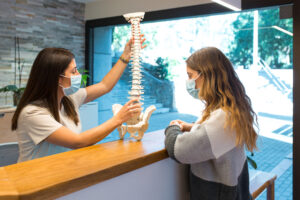
![]() If you have experienced pain from a herniated disc, you know how debilitating it can be. It is natural to look for “quick fix” solutions — like pain medications or surgery — however, these can be invasive, risky, and may fail to treat the root cause of the problem. While something as serious as a herniated disc requires treatment, there are other options that can resolve the problem naturally.
If you have experienced pain from a herniated disc, you know how debilitating it can be. It is natural to look for “quick fix” solutions — like pain medications or surgery — however, these can be invasive, risky, and may fail to treat the root cause of the problem. While something as serious as a herniated disc requires treatment, there are other options that can resolve the problem naturally.
Herniated discs occur when a disc cushioning the vertebrae in your spine becomes damaged or slips out of place. This disc can press up against a nerve, leading to anything from mild to excruciating pain.
Fortunately, there are noninvasive ways to relieve the symptoms of a herniated disc. One of the best options to consider is chiropractic care. Let’s explore everything you need to know about the condition, as well as how an experienced chiropractor can help alleviate pain, speed recovery, and improve your overall spinal health.
What is a Herniated Disc?

A herniated disc, also known as a slipped disc, is more common than you might think. Every year, up to 2% of people get a herniated disc, making it one of the leading causes of back, neck, and leg pain.
The vertebrae, or the small bones that form your spine, are cushioned by discs. These round, pillow-like discs act as shock absorbers for your spine. However, issues can start to arise when the disc starts to bulge or even rupture, causing displacement of the disc. Three of the most common causes of a herniated disc include:
- Spinal wear and tear
- Injury
- A combination of degeneration and injury
A herniated disc can occur in any of the three sections of the spine, including the cervical, thoracic, and lumbar. Typically, a herniated disc progresses through four stages:
- Disc degeneration
- Prolapse
- Extrusion
- Sequestration
Your disc can also herniate if you stretch or move the wrong way. This can come from lifting heavy objects, getting in a car accident, or even when you’re just lying or sitting down. In many cases, it starts as a minor inconvenience, with mild pain or discomfort, but it can become a more significant issue down the line. As the condition progresses, it can lead to severe pain that interferes with your quality of life. Some people suffer from debilitating pain that leaves them unable to work or perform their day-to-day functions.
No matter how it happens, ignoring a herniated disc will only let the problem get worse. Treatment is often necessary to fix a herniated disc and stop the condition from disrupting your quality of life.
What Does a Herniated Disc Feel Like?

Could you have slipped or herniated a disc? It’s entirely possible.
The first sign — and the most obvious one — is usually a form of noticeable pain. While you might expect to feel pain in your back, it’s not always that simple. Sometimes you’ll feel pain in your lower back, legs, shoulders, or even your feet.
The pain from a herniated disc can be felt in three different regions of the spine, depending on where the slipped disc is located. These can include:
- Lumbar:
The most common type of herniated disc develops in the lumbar spine — the lower part of your spine. Pain from a lumbar herniated disc affects your lower body, meaning that you might feel pain radiating down your lower back into your legs, as well as leg weakness or inhibited gait.
- Thoracic:
A thoracic herniated disc can be located in the upper or middle back. It can lead to pain radiating down the upper back, including the chest or stomach. In some cases, you might notice difficulty balancing or walking, weakness in the legs, or bladder dysfunction.
- Cervical:
A cervical herniated disc is the second most common type of slipped disc to experience, in front of the thoracic. Symptoms can depend on the vertebrae affected, but you can expect to feel pain in your shoulders and upper arms, as well as muscle weakness, weakened grip strength, or numbness in the fingers.
Pain is the clearest sign of a herniated disc, but it’s not always present. Instead, you might just notice numbness, tingling, or muscle weakness in certain parts of the body. In extreme cases, you might notice difficulty walking or lifting objects. Sometimes, people with a herniated disc don’t experience any of these symptoms at all. Detection of a slipped disc may not be discovered unless an MRI scan is done and highlights the misplacement of nerves and potential soft tissue.
How Does a Chiropractor Treat a Herniated Disc?

If you suspect you might have a herniated disc, you should speak to a local chiropractor who can help. Even if the disc isn’t painful, it can throw off your spinal alignment and lead to bigger problems if left untreated.
Chiropractic treatment offers an effective alternative care option compared to what a general practitioner may recommend. As a natural treatment, it can help you restore your proper alignment without the need for invasive surgeries or potentially harmful medications.
So how exactly does a chiropractor help resolve a herniated disc? Here are some of the steps and techniques they may take to address your pain and get your spine back to where it should be.
Evaluating Your Condition
First, a chiropractor treating a herniated disc will evaluate the condition of your spine. They need to determine the extent of the damage, the overall health of your spine, and the exact location of the slipped disc. During this visit, they will assess your medical history and conduct a physical exam, as well as possible diagnostic tests.
In addition to evaluating your pain, they may check your reflexes, muscle strength, and any numbness or loss of sensation. These signs could indicate the level of severity of the slipped disc.
Not everyone is an ideal candidate for chiropractic care. During this first visit, they’ll check to see if you have any conditions that could disqualify you for chiropractic adjustments, including:
- Spinal cancer
- Advanced osteoporosis
- Bone abnormalities
- High risk of stroke
Treating Your Herniated Disc
Once they’ve identified the root of your problem and confirmed that you’re a good candidate for chiropractic care, your chiropractor will create a treatment plan. Depending on your individual needs, they are likely to suggest a single or variety of techniques to address your spine discomfort.
Let’s break down the four treatment methods they might use:
Flexion-Distraction Technique
Flexion-distraction is a gentle spinal adjustment that works well for patients experiencing moderate to severe pain. It involves stretching the spine to move the herniated disc away from the affected nerve, reducing pain.
To perform this technique, your chiropractor will place you on a specialized table that flexes the spine in a gentle motion. Then, using manual techniques, they may gently apply force to the affected area to return the disc bulge to its proper location in the spine.
Pelvic Blocking Technique
Pelvic blocking is a chiropractic technique that uses cushioned wedges placed beneath the pelvis on either side. These wedges, designed specifically for chiropractic use, can naturally draw your herniated disc away from the nerve.
This technique is designed to allow the body to make its own adjustments, naturally relaxing the muscles and ligaments.
Spinal Decompression
Spinal decompression is often a critical therapy option that helps address a herniated disc. By softly stretching the spine, the spinal position can reset, allowing negative pressure to release from the affected bulging disc(s). This stops the tension building near the surrounding nerves and helps promote the movement of water, oxygen, and nutrient-rich fluids into the disc(s) leading to healing the area. Spinal decompression also is a positive ongoing maintenance option to prevent future herniated discs.
Physical Therapy
Similar to how spinal decompression helps structurally address a bulging disc, physical therapy acts in the same fashion. By reducing stress and pressure along the spinal discs, the affected nucleus pulposus can retract and return to its original position. During physical therapy, an individual will work on various exercises to stabilize the spine’s position and then move to increase flexibility and available range of motion.
Looking Into Additional Treatments
Your chiropractor might recommend additional treatments to supplement your treatment plan to help with your healing. Extra services like fascial stretch therapy or massage therapy can help relax the muscles, promote blood flow, reduce inflammation, and help you manage the pain from a herniated disc.
Herniated Disc Treatment in Denver, CO
While some herniated discs require the care of both a chiropractor and a specialist or spine surgeon, most cases can be resolved through noninvasive procedures conducted by your local chiropractor. If you want to explore natural treatment to resolve a herniated disc, a chiropractor is the best place to start.
If you’re located in Denver, CO, you don’t need to go far to find the right chiropractor near you. At Reinhardt Chiropractic, our staff of specialists can create a personalized, holistic plan to help you treat your condition. Whether you’re looking for herniated disc treatment in Denver or need help with another condition, like anxiety, back pain, tension headaches, sports injuries, and more, we are dedicated to improving the quality of life for our community members. Learn more about our range of services or schedule an appointment with us today!
Recent Post
Managing Stress and Tension: How Chiropractic Care Can Help
July 1, 2024
In our fast-paced world, stress and tension have become ever-present. Whether it’s the demands of work, family responsibilities, or the challenges of everyday life, many of us are constantly battling stress. At Reinhardt Chiropractic, we believe in a holistic approach to health that addresses not only physical pain but also the underlying stress that can
Read More…
Understanding the Benefits of Chiropractic Care for Athletes: Enhancing Performance and Preventing Injuries
June 1, 2024
In the world of sports, athletes are always seeking ways to improve their performance and prevent injuries. One often overlooked yet highly effective method is chiropractic care. At Reinhardt Chiropractic, we understand the unique demands placed on athletes and how chiropractic care can be a game-changer in their training and recovery regimes. Enhancing Performance Improved
Read More…

